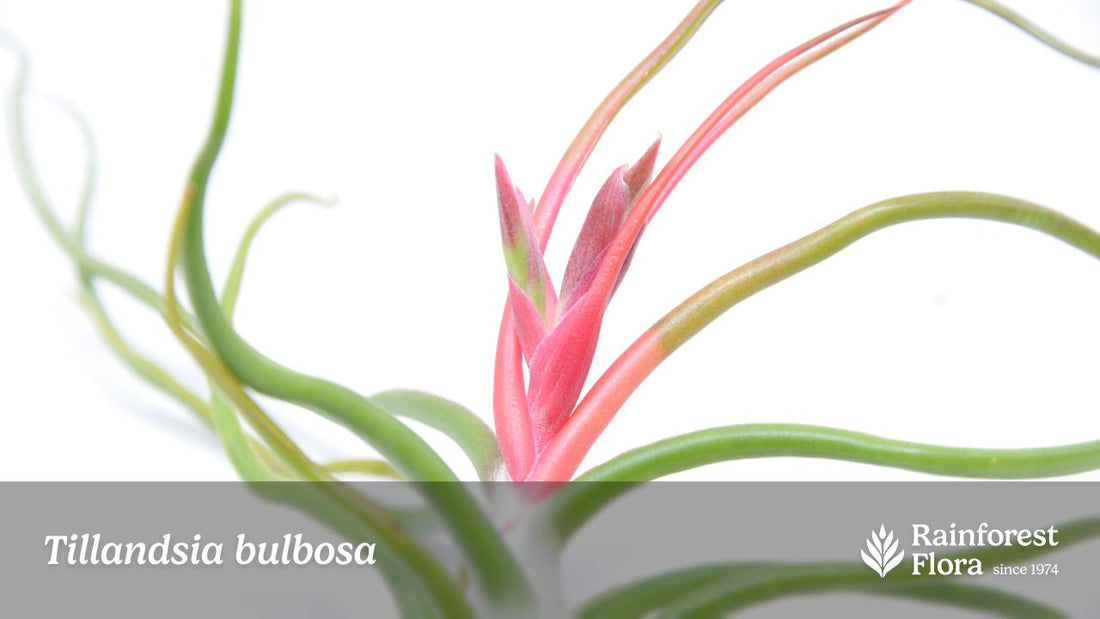
Notes from Tillandsia II: Tillandsia bulbosa
Share
When our co-founder, Paul Isley, wrote Tillandsia II, his guide to Tillandsia species, cultivars, and hybrids, we never imagined its impact. Thousands of plant lovers have told us how this book shaped their horticultural journey.
To celebrate its legacy, we'll share excerpts here, one plant at a time. If you're new to Tillandsia, we hope it sparks a lifelong love. –the Rainforest Flora Team
Tillandsia bulbosa
Hooker: 1826
(bul-BOE-sa)
Subgenus: Tillandsia
Bulbosus is an adjective that means "bulbous." The reference is to the swelling of the plant base.¹
Tillandsia bulbosa has a wide distribution, ranging from Mexico and the West Indies, through Central America, and into Ecuador and northern Brazil. It grows epiphytically on shrubs and trees at elevations from sea level to 1,300 meters. This is a myrmecophytic (ant plant) species with a pseudobulbous base that is characteristic of those types of tillandsias.
I once had occasion to observe this beauty firsthand along the banks of Rio Dulce on the Atlantic side of Guatemala. The solid green wall of foliage along the river's edge was peppered with brilliant red dots of Tillandsia bulbosa in bloom. One could easily see how hummingbirds would be greatly aided in their search for nectar and pollen foodstuffs. The plant is ageotropic (grows irrespective of gravity) and, in nature, is often seen on branches growing horizontally or upside down.
Tillandsia bulbosa is a few-leaved, stemless plant that varies greatly in size. An average adult is about 15 cm across and 12 cm in height. In bloom, specimens sometimes grow to twice that size. The morphology of T. bulbosa is similar to that of T. butzii and Tillandsia caput-medusae. The leaf sheaths are orbicular (more or less round in shape) and the blades are involute and wavy; but unlike the softer leaves of T. butzii, they are stiff. The abaxial (outer) surfaces of the blades appear glabrous and green, but they are actually covered with small, widely dispersed and appressed trichomes. The scales of the adaxial (upper or inner) blade surfaces are more pronounced but difficult to see because the blades are greatly involute-subulate (leaf edges greatly inrolled; awl-shaped). The bases have an indumentum of finely appressed trichomes and the margins of the leaves are amaranth.
Interestingly, the trichomes of Tillandsia bulbosa and T. butzii vary from other tillandsias in that they change their shape and purpose significantly from one side of the leaf to the other. They are fewer in number on the abaxial leaf surface and they're not flexible and hinged like those of the other atmospherics.
The inflorescence is rarely simple but usually subdigitate. The spikes are spreading, lanceolate, and complanate. The floral bracts are imbricate and covered with finely appressed scales.
When blooming, the inflorescence and upper leaves become cherry. With lavender flowers and fern green, silver, and amaranth sheath margins, it is one of the most striking species in the genus.
Tillandsia bulbosa prefers medium light, high humidity, and frequent watering, especially in areas of significant air movement. Tillandsia bulbosa is a plant that can be grown as many ferns—frequent watering and medium levels of light. As long as adequate moisture is available, high temperatures can be tolerated. It is as hardy as most of the other medium to light species. If positioned horizontally or upside down to help prevent possible rot, T. bulbosa can be well grown in a terrarium or vivarium.
¹ A characteristic of myrmecophytic plants.

